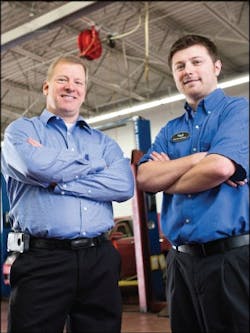The problem was obvious, Mark Butitta says. It was obvious to his family, to his staff, to the members of his 20 Group, to himself.
“I lost my fire,” he says. “We were just squeezing by—paying last month’s bills with next month’s money. I just didn’t have the motivation to do it anymore, and I wasn’t motivated to really make any changes.”
This was 2008, right after the recession hit and right after Butitta’s father passed away, leaving him solely in charge of Mark’s Auto Service in Rockford, Ill. He plugged away for the next year or two, head down, scraping by with what he looks at now as fairly shabby sales numbers. In 2010, the four-person, four-bay shop did just $380,000 in sales.
Those figures weren’t enough to allow for any comfort in the business’s future, which Butitta hoped would be the basis for his retirement.
“Well, I went to a 20 Group meeting and they said I needed to change this, change that, work on this,” he says. “They gave me this whole list of things I needed to do, but they could just see that I wasn’t interested. But they wouldn’t give up. They kept at me.”
Finally, Butitta relented and said yes—a word that would become the foundation for reinventing his family’s 60-plus-year-old business.
The Background
Butitta’s father founded the business in downtown Rockford in 1949 as a heating and cooling shop. Gradually, the family business transitioned to radiator service and eventually it switched to full automotive repair.
Butitta joined full time in 1977, partnering with his father.
There have been a number of other area shops operating under the Butitta name over the years (Butitta’s brothers owned nine shops of their own at one point before selling), and Butitta and his father opened a second location in Rockford 28 years ago. They eventually sold the downtown location and focused on the second facility located on the edge of town.
And for the next 20 years, Butitta operated the single location on the edge of town as Mark’s Auto Service.
The Problem
Fixing cars was never an issue, Butitta says, neither was keeping customers coming back. And during the 1990s, the business thrived, pulling in between $30,000 and $40,000 in monthly sales.
The shop kept that up for years, Butitta says, which is where the problems began.
“We never had a hard time fixing cars, and we had a good reputation,” he says. “We just weren’t growing. I felt like we couldn’t grow.”
Jeremy O’Neal, founder of Advisor Fix, offers his thoughts on how shops can effectively say yes to customers.
From a service advisor standpoint, it never makes sense to say no. When I worked on a front counter, or when I’m in helping shops in the counter today, it’s always been incredibly hard to say no to a customer that just walked in your door.
If that’s a first-time customer, chances are, they’re going to go look for an alternative when you do that.
But, it’s not easy to make it work for every customer. There are really two keys to doing that.
1. Handle the customer’s transportation problems. Customers don’t often have vehicle issues by appointment, so they’re not often prepared for it to happen. You need to get that car in and figure out what’s wrong with it as quickly as possible, but you also have to resolve the customer’s transportation issues. You have to figure out alternative transportation or a ride or a shuttle.
2. Have a firm grasp of the shop’s scheduling. The biggest pitfall with this is promising something you can’t deliver. You have to understand the time and space available in the shop. Do whatever you can to get them in, but don’t set up unrealistic expectations.
Facts were facts, Butitta thought. His shop had just three lifts, and including himself and longtime service manager Terry Smith, who’d joined the company around the same time Butitta did, there were four people on staff. How could the shop grow if there wasn’t space or manpower to take on extra work? They already felt maxed out.
“We just stayed stagnant, doing the same thing over and over again,” Smith says. “It was one of those things where something had to give.”
And Butitta was worried it would “give” in the wrong way. Overhead and variable costs continued to rise as car count and average repair orders stayed flat. Jumping ahead to 2010, Butitta hit a breaking point.
The Options
The number caught him by surprise: $1.5 million.
Sitting in a 20 Group meeting, Butitta had given all of his shop’s specifics—square footage, employees, lifts, and more—and $1.5 million was the number he was given for his shop’s potential revenue.
“And you hear people talk, and they’re sitting there with four bays and doing those types of numbers,” Butitta says. “It was a wake-up call.”
But, if Butitta was to get there, warned his group moderator, longtime industry consultant Gary Gunn, he would have to make changes to all facets of his business, from equipment to staff to his entire sales philosophy.
And to do that meant investing heavily back into his business, which was a risk. It was either that or slowly go out of business, Butitta says.
The Decision
The one thing Butitta says was clearly on his side was proof—the various members of his 20 Group that employed the same strategies and succeeded. He decided to plunge right in.
The premise for the group’s business philosophy is based on a blueprint created by industry serial entrepreneur Greg Sands, who has founded dozens of high-profit, million-dollar facilities across the country. And Sands’ entire process can boil down to one word: yes.
“The best way to explain it,” Butitta says, “is to make things convenient for the customer when it’s not convenient for you.”
That means not only taking walk-ins and small jobs like oil changes—something Butitta rarely did prior—but making the customer that walks in the door, or calls in, the absolute priority of the shop staff at that moment. Get the car in the bay and go from there; don’t let customers walk out the door—that’s the idea.
To do that, Butitta would need to overhaul operations, adding equipment, reorganizing the shop, hiring additional staff and implementing standard operating procedures.
“I decided to just do it in baby steps, focusing on one thing at a time,” he says.
First, he replaced old tools and equipment and added three lifts. All in all, he put roughly $100,000 into re-equipping his shop, which he financed at zero interest through his Carquest jobber.
He then resituated the lifts and bays in his shop to allow for better workflow, and altered his shop’s procedures for not only handling the repair process but for handling the way customers are treated when they enter the shop. Butitta and his staff began to focus on that initial interaction as a priority, ensuring they give the customer their full attention.
Then, that vehicle would become the priority; his staff would pull it around right away to an open bay—or move a car to open one—and complete a full, thorough inspection of the entire vehicle, whether it was in for a major repair or a fluid change.
Slowly, Butitta started to add staff as car count started to rise. His son, Tad, who grew up in the shop but had spent the previous several years working in management for Best Buy, came back to the business to serve as operations manager in 2011.
And with the changes in full swing, the Butittas looked for a big jump in 2012.
The Aftermath
In 2012, Mark’s Auto Service did $600,000 in sales, a 33 percent jump from the previous year, with eight total staffers (including both Butittas). In 2013, they did nearly $1.1 million. Car count has gone from barely more than 120 per month in 2011 to above 450 in 2013.
And the shop is profitable for the first time in years.
“Well, we went from not having any money each month, maybe close to going out of business, to now having two reserve accounts,” Tad says, noting that the initial equipment and tool investments are also paid off already.
Tad admits that when people hear of the “yes” mentality, they think shops are simply giving money away. It’s not the case, he says. The Butittas raised their labor rates and began using a parts-pricing matrix to ensure proper mark-up on every job. And they are focused heavily on marketing. They spend $35,000 a year on direct mail and other initiatives that are “highly targeted” to their desired demographics, ensuring that those customers they say yes to are the ones they want in the shop.
“[The mentality] is something the whole shop has bought into,” Smith says. “It keeps people motivated, because you feel you’re doing right by the customer.”
The Takeaway
Butitta and his son have very different goals moving forward—both dependent on the company continuing its growth.
“My dad is looking more at retiring in the next few years,” Tad says. “I’d like to see us get above $1.3 million and continue that growth, and then look to open a second location.”
Either way, both Butittas feel the overriding message behind their company’s transition is one that should be universal to all businesses in the repair industry.
“You can’t be afraid of changing,” Butitta says. “It’s easy to look at the investment and the time commitment and things and think that it can never be done. But the fact is it can be done, and it needs to be.
“We’re not anywhere near where we want to be, and we’re going to keep moving forward. That should always be the focus in a business—moving forward.”
About the Author

Bryce Evans
Bryce Evans is the vice president of content at 10 Missions Media, overseeing an award-winning team that produces FenderBender, Ratchet+Wrench and NOLN.
